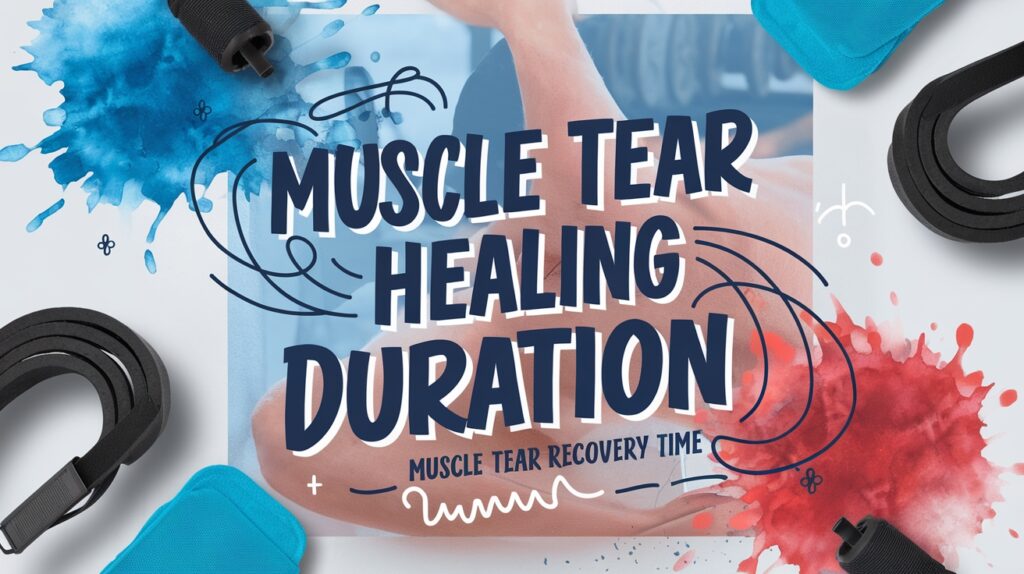Muscle tear recovery time depends on the severity of the injury. Mild tears typically heal in 2-4 weeks, while moderate strains may take 4-8 weeks for recovery. Severe muscle tears can require several months and often need surgical intervention. Early intervention and rehabilitation can greatly impact your healing process. By following best practices, such as consulting a physiotherapist within 3-5 days, you can enhance recovery. Uncovering more about the stages of recovery will provide further insights into effective healing strategies.
Understanding Muscle Tears
When you experience a muscle tear, often referred to as a muscle strain, it’s vital to understand the varying degrees of severity that can impact your recovery time. Muscle tears are classified into three grades: grade I, grade II, and grade III. A grade I tear is mild, typically healing within 1-3 weeks, while a grade II tear is moderate, requiring about 3-6 weeks for recovery. In contrast, a grade III tear is severe and may necessitate several months of healing, possibly including surgical intervention. The recovery process consists of three phases: inflammatory, proliferation, and remodeling. Early intervention using the RICE method—rest, ice, compression, and elevation—can notably reduce recovery time and prevent long-term complications. Understanding these factors is essential for effective recovery.
Recovery Timeline for Muscle Tears
Understanding the recovery timeline for muscle tears is vital for anyone looking to navigate the healing process effectively. Recovery time varies considerably based on the severity of the tear. Mild strains typically heal within 2-4 weeks, while moderate strains may take 4-8 weeks. Severe tears can require several months for complete recovery. You’ll notice a considerable reduction in soreness and improvement in function within 6-10 weeks, although full maturation of muscle fibers might take up to six months. Early intervention, particularly physiotherapy within 3-5 days post-injury, can help reduce recovery time and minimize long-term complications. Keep in mind that overlapping healing phases occur simultaneously, so setting realistic expectations is vital as you progress through recovery.
Stages of Muscle Recovery
The recovery process for a muscle tear unfolds through distinct stages, each playing a significant role in healing. Initially, you enter the inflammatory phase, lasting 1-3 days, where tissue destruction occurs, leading to pain and swelling. Following this, the proliferation phase begins 24-48 hours post-injury, focusing on regenerating and activating healing tissues. During this phase, you might notice some improvement in soreness and functionality. Finally, the remodeling phase can last up to a year or more, as muscle fibers mature and regain strength. While most injuries feel better within 6-10 weeks, full recovery can take up to six months. Understanding these overlapping stages helps set realistic expectations and underscores the necessity of early intervention for ideal healing.
Best Practices for Rehabilitation
Effective rehabilitation following a muscle tear is essential for a successful recovery, as it guarantees that you regain strength and functionality while minimizing the risk of re-injury. In the first three days post-injury, implement the Peace & Love principles: Protection, Elevation, Avoidance of aggravating activities, Compression, and Load management. Schedule a physiotherapy appointment 3-5 days after the injury to initiate a tailored rehabilitation plan focusing on pain management and gradual strength building. Start with gentle stretching and mobility exercises to maintain range of motion before progressing to strengthening activities, as pain allows. Monitor your healing closely; significant improvement usually occurs within 6-10 weeks, but full recovery may take several months. Consistent follow-up and adjustments to your plan are essential.
Signs You Need Medical Attention
Recognizing when to seek medical attention after a muscle tear can greatly impact your recovery process. If you experience persistent pain after a week that doesn’t improve with rest and self-care, it’s essential to consult a healthcare professional. Numbness or tingling in the affected area may indicate nerve damage, which requires evaluation. Additionally, if you notice blood at the injury site or significant swelling that doesn’t subside, these symptoms could suggest a more severe injury requiring intervention. You should seek immediate medical care if you’re unable to walk or move your limbs, or if severe pain prevents weight-bearing. Finally, difficulty breathing or significant chest pain after a muscle injury demands urgent medical attention due to potential complications.
Prevention Strategies for Muscle Injuries
After addressing the signs that indicate the need for medical attention, it’s important to contemplate how to prevent muscle injuries in the first place. Regularly engaging in stretching exercises before and after physical activities enhances flexibility, reducing the risk of strains. Incorporating strength training into your routine builds muscle resilience, helping to prevent injuries from overexertion or sudden movements. Maintaining proper hydration is essential, as dehydration can lead to muscle stiffness and increased injury risk during physical activities. Utilizing appropriate warm-up techniques tailored to each activity prepares your muscles for exertion, minimizing the likelihood of strains. Additionally, avoid prolonged periods of sitting and take frequent breaks to promote circulation, which helps prevent stiffness and potential muscle injuries.
Importance of Early Intervention
When you sustain a muscle tear, the urgency of early intervention can’t be overstated, as addressing the injury within the first few days plays an essential role in your recovery. Early intervention, particularly within the first 3-5 days, greatly reduces the risk of long-term weakness and re-injury by promoting effective healing. Implementing the Peace & Love principles—Protection, Elevation, Avoidance of aggravating activities, Compression, and Load management—helps manage inflammation and pain. Scheduling a physiotherapy appointment soon after the injury allows for personalized rehabilitation plans tailored to your needs. Engaging in early pain management techniques enables a gradual shift to strength-building exercises, vital for restoring muscle function. Prompt attention to muscle injuries not only speeds recovery but also enhances overall athletic performance.

